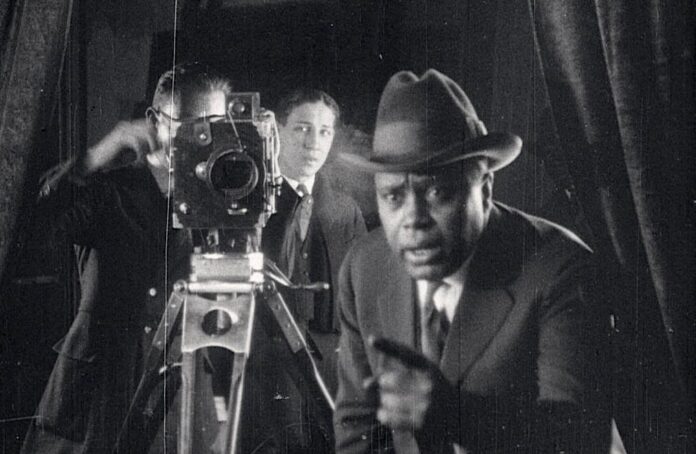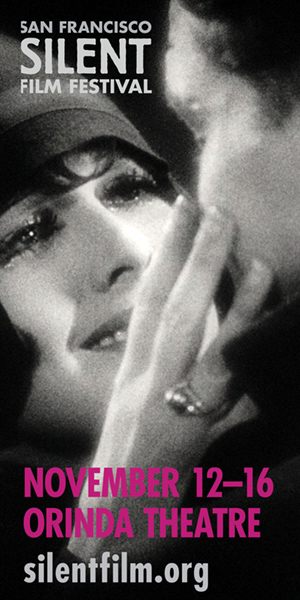Midway through Black History Month, it’s worth noting the relative brevity of Black film history—the very first major-studio feature to be directed by an African-American didn’t come along until 1969, when the industry had already been in existence for decades.
That movie, The Learning Tree, happens to be getting a relatively rare big-screen revival at the Balboa next Tues/18. It was a lyrical, loosely autobiographical fiction from photographer Gordon Parks, whose next project—the original Shaft—would set a template for commercial Black cinema for years to come. Let’s hope some day there’s attention paid to his last and best feature, the 1976 blues biopic Leadbelly, which was not only got largely overlooked at the time but has since available in little beyond very low-grade copies that give scant indication of its visual magnificence.
The Hollywood history of minority representation is well-known by now, basically as an abyss of stereotypes and occasional good intentions almost singlehandedly lifted upward by Sidney Poitier in the years prior to Tree. But there was another, parallel history in the US, one still under-explored. That would be the world of “race films,” targeting African-American audiences, a scrappy sub-industry that existed from the early 1910s to around 1950. You can’t say “flourished,” because these so-caleld “sepia” enterprises were limited to playing a tiny percentage of theaters nationwide, many of which were intensely rivalrous—so even a bona fide hit might have difficulty getting many bookings, let alone turning a profit.
The king of “race cinema” was Oscar Micheaux, a midwesterner who arrived at his profession relatively late, at age 35. One of thirteen children, but driven to succeed like no other, he’d already tried numerous trades, including a substantial stint as a landowning farmer in South Dakota. (He might have stuck with that, too, if after several years’ good harvests drought hadn’t wiped out he and most of his neighbors.) Always a tireless self-promoter, he began turning his own experiences into novels like The Homesteader, then decided to film it himself when a deal with producer fell through. Once bitten, he stayed bit: After that first effort in 1919 he made at least 40 features, becoming by far the most famous African-American celluloid impresario—even if his work was scarcely ever noticed or mentioned outside the Black press.
Micheaux was remarkable for his resourcefulness (and hyperbole) under near-impossible circumstances. The grandiose image he built for himself belied the almost constant evasion of creditors, punishingly low budgets (apparently never more than $15,000) he had to work with, and endless fights with censors in every state. His films seem inoffensive enough now, but keep in mind that back then white authorities applied standards they never would have to mainstream films—such as worrying that any content addressing racial injustices might “incite” Black audiences.
As they’ve been rediscovered in recent years, they’ve also triggered some laughter for their dated conventions and often crude technique. Some of this was doubtless due to financial straits, but other aspects (like his tacit adherence to skin-tone hierarchies) reflect a more personal fixation that even some community leaders found objectionable at the time. Both in movies and in life, Micheaux was a complicated, sometimes contradictory character. The truth about him no doubt lies somewhere between the valedictory nature of something like Patrick McGilligan’s tome The Great and Only—probably the best Micheaux biography, though it bends over backwards to excuse his flaws—and critic J. Hoberman’s dismissal of the director as a figure of helpless so-bad-it’s-good camp fascination, a la Edward D. Wood, Jr.
We’ll never know, in part because Micheaux’s widow destroyed correspondence and archives after his 1951 death. But mostly because only a third of his voluminous screen output survives—nearly all his silent features are gone, and many “talkies” too, including his final, three-hour magnum opus The Betrayal (1948). What’s left is itself often fragmentary, with never-restored censors’ cuts compounding the problems of frequent poor sound recording, deteriorated prints, etc.
Nonetheless, it’s like raising the Titanic to probe through Oscar Micheaux: The Complete Collection. That Blu-ray set just released by Kino Lorber contains 15 more-or-less intact titles, plus several trailers for films no longer known to exist, much of this material newly restored. What surfaces may be worse for wear, but the very reality of having it in one’s hands (and on your screen) provides a revelatory window onto a past more quirky and diverse than expected.
Help us save local journalism!
Every tax-deductible donation helps us grow to cover the issues that mean the most to our community. Become a 48 Hills Hero and support the only daily progressive news source in the Bay Area.
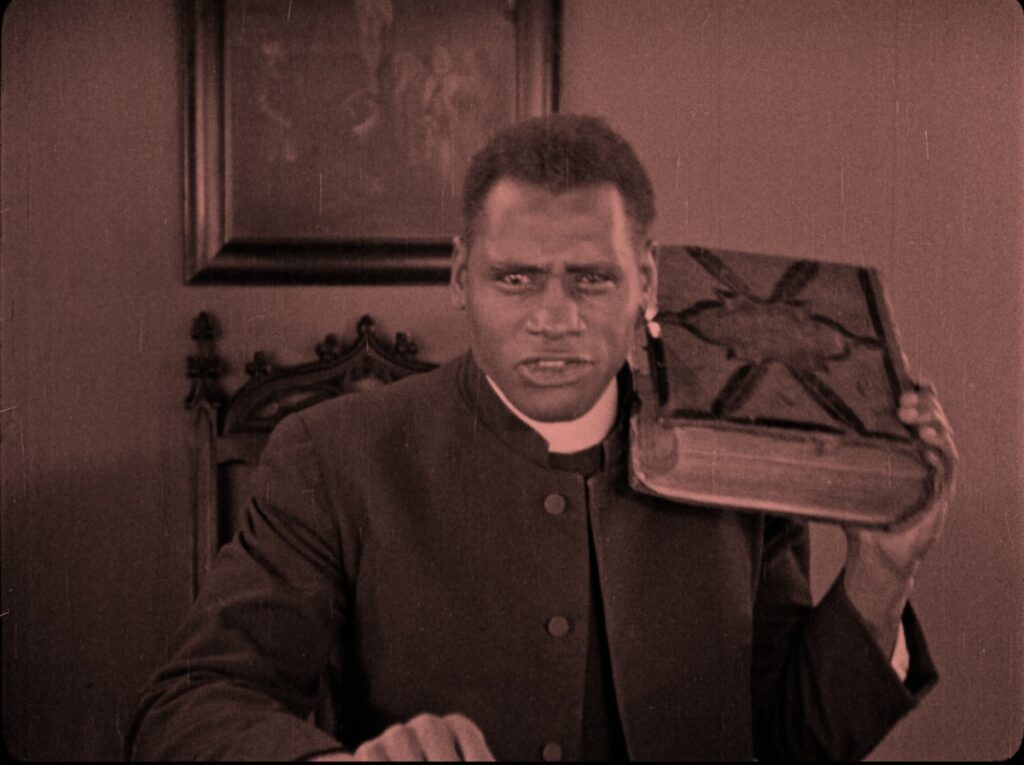
Seeing a Micheaux film in isolation—typically, it’s been his silents Within Our Gates (1920) and Body and Soul (1925), the latter starring young Paul Robeson in dual roles—can indeed make him look creaky and bizarre. The more you watch, however, the more you realize comparisons to Hollywood product are beside the point. His movies are their own universe, with frequent recycling of plots and themes (he often remade his own features), as well as actors who appear many times over, whether recruited from Black theater circles or amateurs picked off the street.
The peculiarities extend to his usually setting stories within an aspirational middle-class milieu, and having his characters speak a particularly stilted notion of “the Queen’s English.” They say things like “No, emphatically no!” and “I shall always be pointed out as a convict.” The melodramatic scenarios often sport an obsession with “passing” as white. The rigidity of using almost nothing but stationary medium shots doesn’t allow the “all-star colored casts” to participate in much action.
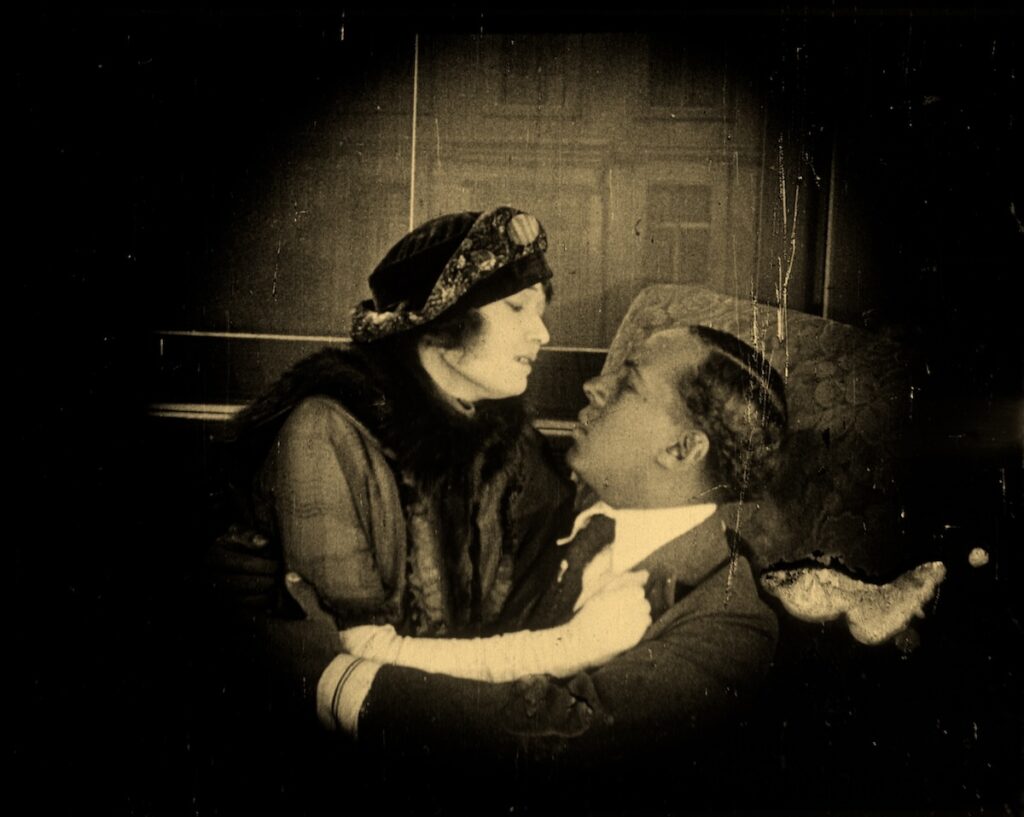
Yet as awkward, damaged, and unevenly acted as they can be, Micheaux’s films still deal with systemic racism (a Black protagonist reporting a crime inevitably gets arrested as its prime suspect), consistently rail against pseudo-religious hypocrisy, and occasionally take head-on such unmentionable subjects as the KKK and lynchings.
Best of all, nearly all the surviving movies are peppered with musical interludes that are almost entirely gratuitous, but provide records of Black nightclub and vaudeville entertainment in the 1930s: Torch singers, choirs, comedians, specialty solo dancers encompassing tap, acrobatic, and quasi-African “exotic.” Most delightful are regular invasions of scantily-clad chorus lines whose members’ individuality is only emphasized by their lack of much choreographic uniformity. (In their defense, these scenes were typically shot after they’d done numerous sets for the night in a real club, so it’s a wonder they had so much pep left.)
Though he moved operations wherever the money was at the moment, Micheaux had his own production company from 1918 to 1940, often spinning features from little more than thin air—even if sometimes they got stuck in the lab, waiting for him to pay his bills. No one can be sure how many films he truly made. He was always announcing projects, and sometimes crew actually remembered shooting them (at least in part). But even beyond the titles known to have been shown before they disappeared—unhelped by the fact that so few prints were made to begin with—there are others that may never have been finished, or got reworked into new forms.
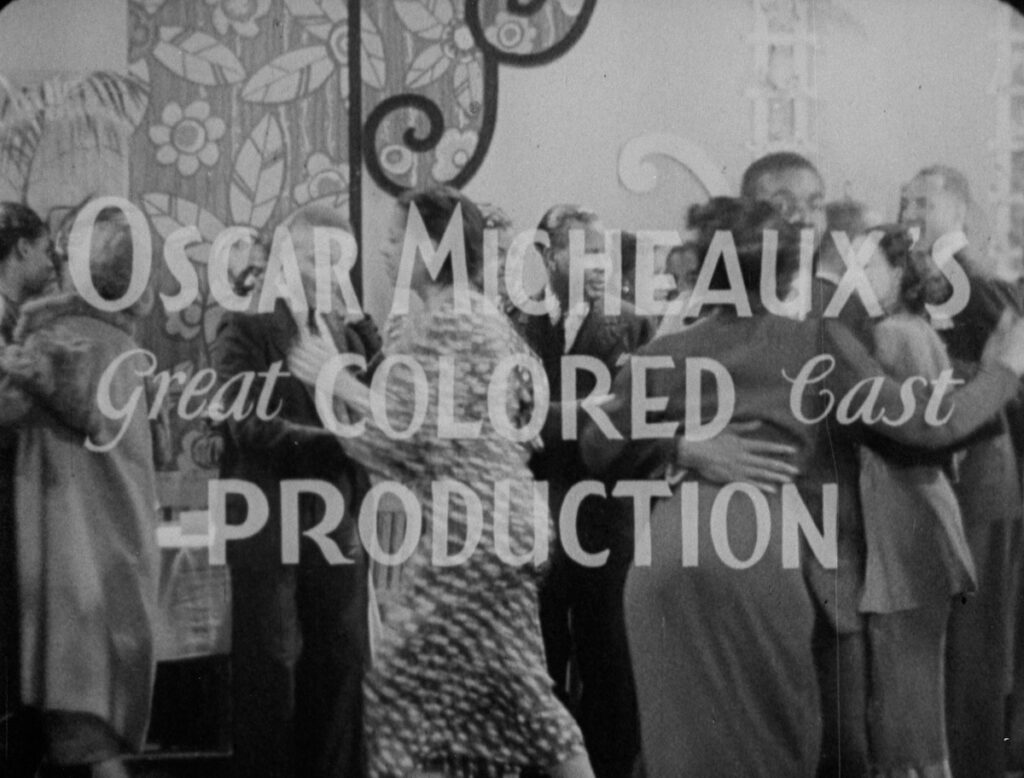
When the finances finally became too forbidding even for his prodigious wheeling and dealing during WW2, he returned to writing novels, apart from one last swing in The Betrayal. Ultimately, his cumulative experience proved somewhat embittering—all the more so because he had been subjected to far more criticism than he had acclaim within the Black press, despite his pioneering. Always an iconoclast, he’d never been accepted by the intelligentsia of the “Harlem Renaissance.” Later on, he was dismissed as behind the times by communities debating a preferred public image well before the dawn of the Civil Rights Movement. If he dramatized grifters and loose women (albeit very mildly by major-studio standards), he was chided as setting a bad example—but then, no one would have allowed him to show harsher realities of economic and physical violence, had he tried to.
The most entertaining of the Kino box excavations—like breathless indictment Within Our Gates (considered by some a riposte to Birth of a Nation), glorified 1938 revue Swing!, the same year’s God’s Step Children, and 1940’s equally juicy The Notorious Elinor Lee (which stars James Earl Jones’ father Robert as a boxer)—have complicated agendas that speak to their creator’s singular perspective. They’re choppy, at times perplexing, technically below what even the mainstream industry’s “Poverty Row” studios managed at the time. But for all their inconsistencies, they have the consistent vision of a real auteur—Micheaux blazed a trail that was very much his eccentric own. Separately, Kino Lorber is also releasing a DVD of a prior documentary by Francesco Zippel, Oscar Micheaux: The Superhero of Black Filmmaking, which includes input from interviewees John Singleton, Morgan Freeman and Chuck D. Many of these titles are also available for streaming from kinofilmcollection.com
That trove isn’t the only Black cinema backstory getting dusted off this week. A later wave of African-American filmmaking is examined in Spirits of Rebellion: Black Independent Cinema from Los Angeles. Zeinabu irene Davis’ 2016 documentary pays tribute to Ethnocommunications Programs started at UCLA for Latino, Asian American and Black students a few years after the Watts Uprising, with a goal of teaching minorities “how to make films.” Among the most famous alumni were Charles Burnett (To Sleep With Anger), Jamaa Fanaka (Penitentiary), Julie Dash (Daughters of the Dust), Billy Woodberry (Bless Their Little Hearts) and Haile Gerima (Sakofa). But this film, mixing interviews with vintage clips, whets the appetite to track down titles by others whose work has scarcely been seen—and god knows even the talents noted above haven’t exactly had Hollywood at their feet. The doc, along with some related titles, is now available for streaming here.
While that artistic movement largely articulated struggle, a Bay Area talent who emerged around the same time communicated pure joy and unity to a vast audience—until, suddenly, it all seemed to vanish overnight. That would be Vallejo-raised Sly Stone, whose racially and gender-integrated Family Stone crossed all bounds of musical genre and popularity just on either side of 1970. Questlove’s Sly Lives! (aka The Burden of Black Genius) recaptures that giddy ride, which swept diverse listeners into a mix of funk, soul, psychedelia, rock and experimentation that Clive Davis calls a “totally unique blurring” over half a century later. Other interviewees here include surviving band members, the Chronicle’s Joel Selvin, and subsequent collaborators or admirers like Vernon Reid, D’Angelo, Jam & Lewis, Nile Rodgers, Andre 3000, George Clinton, Chaka Khan, Dream Hampton, Bobby Womack, and Q-Tip.
One person not interviewed (save in archival clips) is The Man Himself—who’s been MIA so long, it comes as a surprise at the end when you realize he’s being referred to in the present tense, because Stone is still alive. What happened? Well, drugs—Clinton, who toured with him in the 80s, flatly says “We were crackheads.” But this “Black hippie Pied Piper” who was “the highlight of Woodstock” also suffered from a syndrome of excessive expectations and cultural pressure that, it’s said here, can make “success more frightening than failure.”
A voice for unbridled optimism in a brief time of extraordinary high hopes, Sly grew disillusioned like everyone else—and wasn’t interested in sticking around as a Greatest Hits nostalgia machine. It’s ultimately a somewhat sad and mysterious story. But Sly Lives! is also largely pure bliss, as it recaptures the ecstatic high of an act that was like nothing else before it, and without which the likes of Prince (for starters) could never have existed. The documentary begins streaming this Thurs/13 on Hulu.
One still-alive-and-active artist whose genre-bending virtuosity recalls Stone is Oakland’s own Fantastic Negrito aka Xavier Amin Dphrenpaulezz, who says he began teaching himself to play music after hearing Prince’s Dirty Mind. Ah… circle of life! Since then, he’s released several albums, won a couple Grammys, survived a coma, taken a seven-year break—and gotten very busy of late.
This Fri/14 sees A Fantastic Negrito Valentine! at the 4-Star, two shows that will each encompass a solo acoustic performance plus screening of his White Jesus Black Problems. That mid-length mix of music video, collage, American history, dance, and archival materials has a loose plot revolving around a forbidden 18th-century interracial romance. It’s hardly on the budgetary scale of something like Beyonce’s Lemonade…yet you could argue this 42-minute “companion film” to the same-named album, directed and shot by Aerick Neal, is no less inventive visually or musically. Note: That 2022 multimedia package is already three albums ago for Fantastic Negrito.
Of course, you could skip all this High Art and trunk-digging, instead going straight to the popcorn smorgasbord of Captain America: Brave New World, which is opening in every theater on the planet this Fri/14. Alas, apparently the producers did not get the memo that Black is wack by the time their film came out. So we’ve got Anthony Mackie as an African-American Cap’n, directed by Nigeria-born Julius Onah.
You can just imagine the degree of aneurism-level fanboy conniption that’s simmered for months around this flaunting of dread (we hesitate to even use the word) Diversity, despite the reassuring presence of such firmly Caucasian actors as Harrison Ford and Liv Tyler. The film was not available for preview by presstime. But we feel safer knowing that its existence will probably be scrubbed from the national record sometime in the immediate future. Perhaps the next installment can star someone more acceptable to Jim Crow nostalgists, like Kevin Sorbo, and be directed by the wholesome likes of Mel Gibson.


